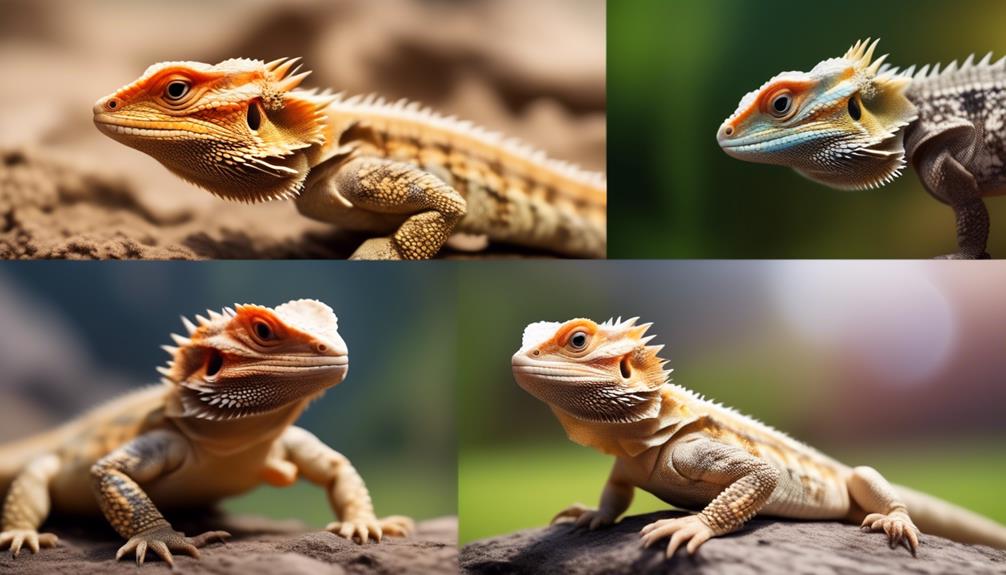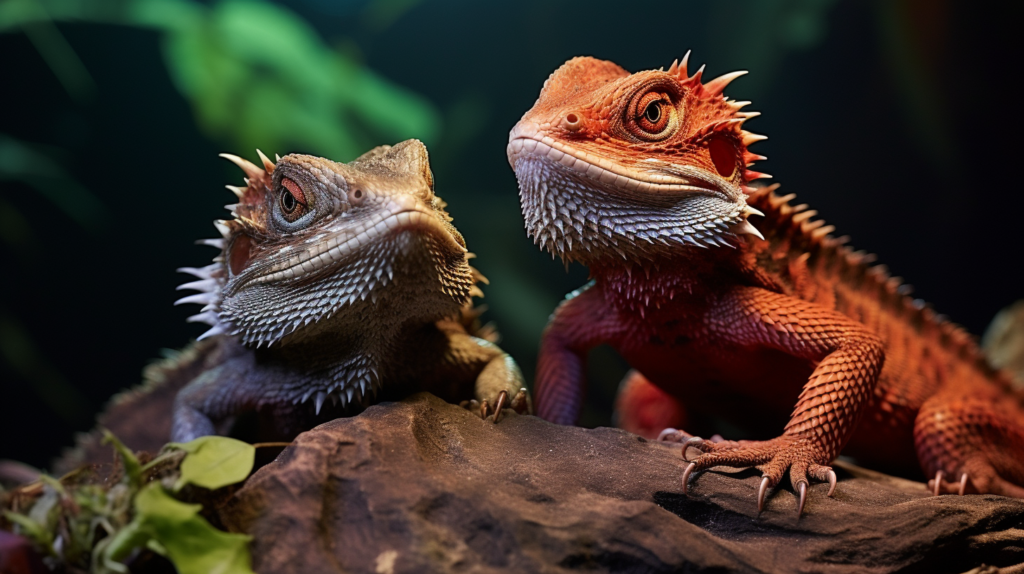As your bearded dragon companion grows, you may notice subtle changes in its size and behavior. Understanding the various stages of growth and development is crucial for providing the best care for your pet.
From the delicate hatchling stage to the majestic adult phase, each age brings its own set of unique characteristics and considerations. By gaining insights into the specific needs of your bearded dragon at each stage, you can ensure that it thrives throughout its life.
So, how does the size of your bearded dragon matter at different stages of its development?
To find out the growth and development of a Bearded Dragon by age, you can monitor their size, behavior, and environmental needs at each stage of their life. Understanding their growth patterns is crucial for providing the best care for your pet, from the delicate hatchling stage to the majestic adult phase. Each age brings its own set of unique characteristics and considerations, such as dietary needs, habitat upgrades, and behavioral changes.
Hatchling Stage: The Early Growth Phase
During the hatchling stage, bearded dragons undergo rapid growth and development, reaching significant milestones in their early life. Providing proper early nutrition is crucial during this stage to support their rapid growth. Hatchlings should be fed a diet of appropriately sized insects, such as appropriately sized crickets and small roaches, dusted with calcium and vitamin supplements. This ensures that they receive the necessary nutrients for healthy bone and muscle development. Additionally, offering finely chopped leafy greens provides essential vitamins and minerals that contribute to overall growth and development.
Environmental factors also play a vital role in the hatchling stage. Maintaining the appropriate temperature gradient in their enclosure is essential for their growth and digestion. Hatchlings require a basking spot with temperatures ranging between 100-110°F (37-43°C) to support their metabolism and overall growth. It’s equally important to provide a cooler side of the enclosure, around 80°F (27°C), to allow them to regulate their body temperature effectively. Proper humidity levels should also be maintained, typically between 30-40%, to support healthy shedding and respiratory function.
Juvenile Stage: Rapid Growth and Development
As hatchlings progress into the juvenile stage, their growth and development continue at a rapid pace, necessitating specific care and attention to support their evolving needs. During this stage, you’ll notice a significant increase in size and weight as your bearded dragon undergoes rapid growth. Their body proportions will begin to elongate, and their limbs will develop more defined musculature.
Here are some key points to consider during this crucial phase:
- Dietary Adjustments: With rapid growth, your bearded dragon’s nutritional needs will change. You should adjust their diet to include more protein and calcium-rich foods to support their developing bones and muscles. Offer a variety of appropriately sized insects and leafy greens to ensure they receive the necessary nutrients for healthy growth.
- Habitat Upgrades: As your bearded dragon grows, their enclosure will need to be upgraded to accommodate their increasing size. Provide a spacious habitat with climbing structures and basking spots to encourage physical activity and healthy development.
- Behavioral Changes: Juvenile bearded dragons may exhibit increased activity levels and curiosity about their environment. They may also display territorial behaviors as they become more confident in their surroundings. It’s essential to provide enrichment opportunities and social interaction to support their mental and emotional well-being during this stage of rapid growth.
Understanding the specific needs of juvenile bearded dragons is crucial for ensuring their optimal growth and development. By providing appropriate care and attention, you can support your pet through this period of rapid growth and help them thrive.
Sub-Adult Stage: Preparing for Adulthood
To ensure the smooth transition of your bearded dragon from the juvenile stage to adulthood, it’s essential to provide tailored care and a suitable habitat that meets their evolving needs for physical and behavioral development.
As your bearded dragon enters the sub-adult stage, you may notice changes in their behavior. They might become more territorial and exhibit dominance behaviors, especially if housed with other dragons. It’s important to monitor their interactions and provide adequate space to prevent aggression.
Additionally, this stage marks a shift in their nutritional needs. While protein remains important, a greater emphasis on leafy greens and vegetables should be introduced to their diet. This will help support their overall health and prepare them for adulthood.
In terms of behavior, you might observe your bearded dragon displaying courtship behaviors as they reach sexual maturity. This might include head bobbing, arm waving, and color changes, especially in males. Providing a suitable environment with hiding spots and separate basking areas for multiple dragons can help manage territorial behavior and reduce stress.
Nutritionally, it’s crucial to ensure that they’re receiving a balanced diet. In addition to live insects, a variety of vegetables such as collard greens, mustard greens, and squash should be offered. Calcium and vitamin supplements are still essential at this stage to support their growth and prevent metabolic bone disease.
Adult Stage: Reaching Full Size
Upon reaching adulthood, bearded dragons typically attain their full size and exhibit behavioral and physiological changes that reflect their mature stage of development. At this stage, they’re ready for reproductive maturity and have specific nutritional needs that are crucial for maintaining their health and vitality.
Here’s what you can expect during the adult stage:
- Size and Appearance: Adult bearded dragons generally reach a length of 18 to 24 inches, from the tip of their nose to the end of their tail. Their bodies become more robust, and their heads appear larger and more defined. The spines along their back and tail also become more prominent, giving them a striking appearance.
- Behavioral Changes: As bearded dragons reach adulthood, their behavior may become more territorial, particularly among males. They may display head-bobbing and arm-waving behaviors as part of their courtship and territorial displays. Additionally, they may become more solitary and less tolerant of being housed with other dragons.
- Nutritional Requirements: Adult bearded dragons require a diet that consists primarily of leafy greens and vegetables, with insects offered as occasional treats. It’s important to provide a well-balanced diet to ensure they receive the necessary vitamins and minerals for their overall health and to support potential reproductive needs.
Understanding the changes that occur as bearded dragons reach adulthood can help you provide the best care for your pet during this important stage of their development.
Senior Stage: Understanding Aging Changes
Entering the senior stage, bearded dragons experience distinct aging changes that necessitate adjustments in their care and habitat management. As your bearded dragon ages, it’s essential to pay close attention to their health care and nutritional needs to ensure they continue to thrive in their golden years.
Health care becomes increasingly important as your bearded dragon enters the senior stage. Regular veterinary check-ups are crucial to monitor for age-related health issues such as arthritis, organ function, and metabolic bone disease. Additionally, maintaining a clean and comfortable habitat is essential to prevent stress-related illnesses and to support their overall well-being.
Nutritional needs also change as bearded dragons age. Senior dragons may require adjustments to their diet to accommodate changes in their digestive system and metabolism. It’s important to provide a well-balanced diet consisting of appropriate levels of protein, fiber, vitamins, and minerals. Offering a variety of vegetables, greens, and occasional treats can help meet their evolving nutritional requirements.
In the senior stage, it’s vital to observe your bearded dragon closely for any signs of discomfort, illness, or changes in behavior. Providing a warm and secure environment, along with regular health check-ups and a carefully tailored diet, will help ensure that your bearded dragon enjoys a comfortable and fulfilling senior stage.
Frequently Asked Questions
Are Bearded Dragons Prone to Any Specific Health Issues During Their Growth Stages?
During their growth stages, bearded dragons are prone to specific health issues. It’s important to monitor their growth rate, assess their diet and nutrition, and watch for behavioral changes. The habitat transition and enclosure size also play a crucial role in their growth development.
How Can I Tell if My Bearded Dragon Is Growing at a Healthy Rate?
To monitor your bearded dragon’s healthy growth, weigh them regularly and track weight gain. Watch for behavior changes, as they may indicate growth spurts or health issues. Adjust their environment as needed for optimal development.
What Kind of Diet and Nutrition Is Essential for Each Growth Stage of a Bearded Dragon?
To ensure healthy growth, your bearded dragon requires a balanced diet tailored to its specific growth stage. Meeting nutritional requirements and understanding growth patterns are crucial. Establish a feeding schedule that aligns with its development.
What Are Some Common Behavioral Changes I Can Expect to See as My Bearded Dragon Grows From a Hatchling to a Senior?
As your bearded dragon grows, you may notice behavioral changes such as increased social development, varied feeding habits, and the need for environmental enrichment. These changes are all part of their natural development and growth process.
At What Age Should I Consider Transitioning My Bearded Dragon to a Different Habitat or Enclosure Size as It Grows?
When your bearded dragon outgrows its current habitat, it’s time to transition to a larger enclosure. Monitor its growth rate and ensure the new habitat allows for healthy development. Gradually upgrading the enclosure size is essential for your dragon’s well-being.
Conclusion
As you watch your bearded dragon grow and develop, remember that their size is a symbol of their health and well-being. Each stage of their life brings new changes and challenges, but also new joys and experiences.
By understanding their growth age by age, you can better care for and appreciate your bearded dragon as they reach their full size and age gracefully.
Enjoy the journey of watching your dragon grow and thrive!


